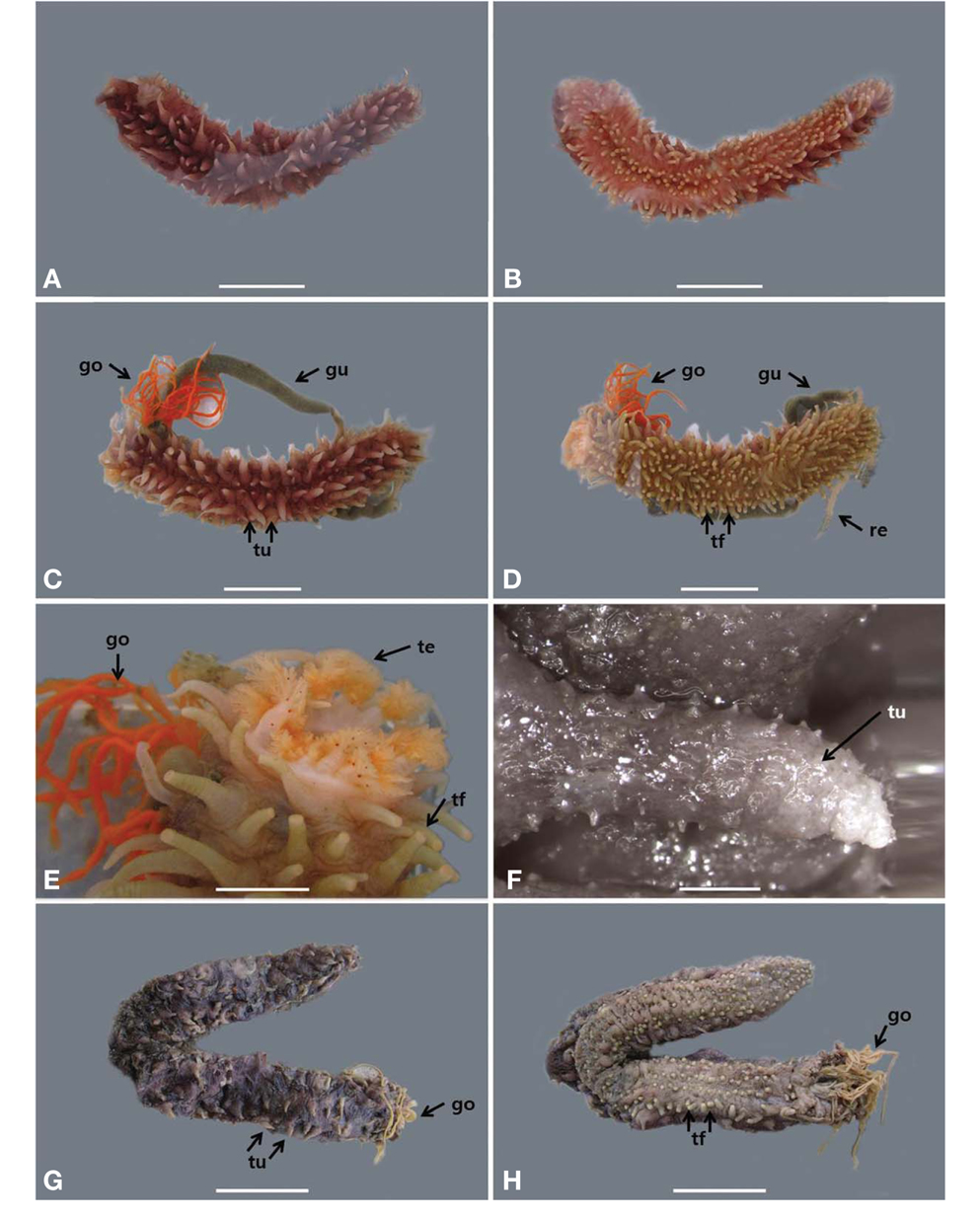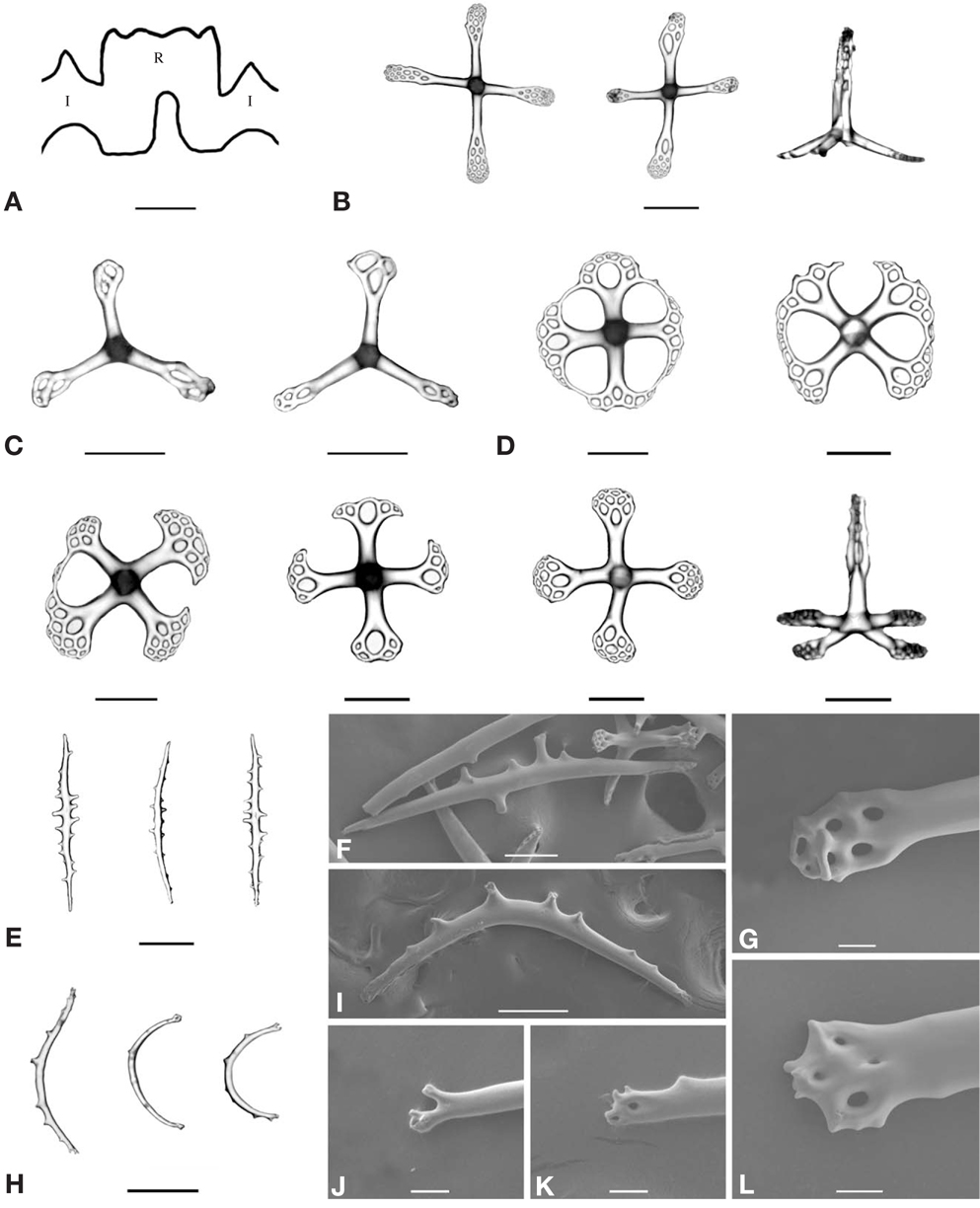



Species of the family Synallactidae comprising mainly deepsea forms are cosmopolitan (Solís-Marín, 2005). Approximately seventeen genera of this family recognized at the present time(Paulay and Hansson, 2013). According to Deichmann (1930), genus
Specimens were preserved in above 95% ethyl alcohol, and their important morphological characteristics were photographed using digital camera(D7000; Nikon, Tokyo, Japan), stereo- and light-microscopy(Nikon SMZ1000, Eclipse 80
Class Holothuroidea de Blainville, 1830 Order Aspidochirotida Grube, 1840
>
Key to the families of order Aspidochirotida in Korea
1. Tentacle ampullae present ∙∙∙∙∙∙∙∙∙∙∙∙∙∙∙∙∙∙∙∙∙∙∙∙∙∙∙∙∙∙∙∙∙∙∙∙∙∙∙∙∙∙∙∙∙∙∙∙∙∙∙∙∙∙∙∙∙∙∙∙∙∙∙∙∙∙∙∙∙∙∙∙2 -Tentacle ampullae absent ∙∙∙∙∙∙∙∙∙∙∙∙∙∙∙∙∙∙∙∙∙∙∙∙∙∙∙∙∙∙∙∙∙∙∙∙∙∙∙∙∙∙∙∙∙∙∙∙∙∙∙∙∙∙∙∙∙∙∙∙∙∙∙∙∙∙∙∙∙∙∙∙∙∙∙Synallactidae 2. One gonad bundle located on left side of dorsal mesentery ∙∙∙∙∙∙∙∙∙∙∙∙∙∙∙∙∙∙∙∙∙∙∙∙∙∙∙∙∙∙∙∙∙Holothuriidae -Two gonad bundles located on left and right sides of dorsal mesentery ∙∙∙∙∙∙∙∙∙∙∙∙∙∙∙∙∙∙∙∙∙∙∙Stichopodidae
Synallactinae Ludwig, 1894: 8; Mitsukuri, 1912: 3. Synallactidae: Ohshima, 1915: 221; Deichmann, 1930: 85; Pawson, 1965: 15; Cherbonnier and Féral, 1981: 358; Rowe and Gates, 1995: 328; Paulay and Hansson, 2013: 123185.
Tentacle ampullae absent. Stone canal usually connected with body wall, sometimes opening outwards through body wall. Respiratory trees usually not connected with a mirabile net. No Cuvierian organ. Tables, rods and very rarely buttons present. Type genus: Synallactes alexandriLudwig, 1894. Genera 17(1 in Korea).
>
Key to the genera of family Synallactidae
1. Table with four-armed disk and a long pillar ∙∙∙∙∙∙∙∙∙∙∙∙∙∙∙∙∙∙∙∙∙∙∙∙∙∙∙∙∙∙∙∙∙Bathyplotes -Table with three-or four-armed disk and a short or no pillar∙∙∙∙∙∙∙∙∙∙∙∙∙∙Synallactes
Synallactes Ludwig, 1894: 21; Mitsukuri, 1912: 11; Ohshima, 1915: 221; Mortensen, 1927: 378; Deichmann, 1930: 106; Cherbonnier, 1952: 473; Solís-Marín, 2005: 570; Massin and Hendrickx, 2010: 600; Paulay and Hansson, 2013: 123471.
Body cylindrical or subcylindrical form. Tentacles 18-20 in number. Small tubercles on dorsal surface distinctly arranged in rows. Each ventro-lateral radius with tube feet arranged in one or more rows. Mid-ventral radius with tube feet arranged in distinct rows. Gonads subdivided into two tufts. Table consisted of a three- or four-armed disk, and a terminally divided or perforated, or both pillar. Type species: Synallactes alexandri Ludwig, 1894. Species 26(1 in Korea).
Synallactes nozowai Mitsukuri, 1912: 23; Ohshima, 1915: 221; Paulay and Hansson, 2013: 529034.
Material examined. 1 specimen, Gisamun, 27 Dec 2009, at 140m depth by trawl; 1 specimen, Gisamun, 25 Dec 2010, at 170 m depth by trawl; 1 specimen, Gonghyeonjin, 16 Oct 2011, at 180m depth by trawl; 2 specimens, Gonghyeonjin, 14 Nov 2012, at 160m depth by trawl.
Description. Body elongated, cylindrical, with slightly flattened ventral side, and distinctly divided into ventral and dorsal portions. Body wall thin, flexible, and a little translucent (Fig. 1A-D). Mouth bent toward ventral side, and surrounded by a circle of small tubercles. Tentacles 18 in number(Fig. 1D, E). Anus terminal, and subdorsal(Fig. 1D). Each of two dorsal ambulacra composed of a narrow double row of conical tubercles, which carry a number of microscopic whitish warts(Fig. 1F), which also present on dorsal interambulacra, and scantily on ventral surface. Tube feet on ventral side arranged in three longitudinal rows, each row forming a zigzag(Fig. 1B, D, H). Calcareous ring remarkably thick, simple, with no differences between dorsal and ventral sides, and a radial plate with deep median furrow(Fig. 2A). Ossicles of body wall include table consisting of a three-(tri-radiate) or four-armed(cross-shaped or quad-radiate) disk and a spireform pillar: each end of arm enlarged and flattened, with irregular sized holes; each pillar terminally divided, with several cross beams, and with irregularly serrated edges on tip (Fig. 2B-D). Table usually four-armed(Fig. 2B, D) or very rarely three-armed(Fig. 2C). Rod of tube feet has irregular thorns(Fig. 2E, F), and perforated flat ends(Fig. 2G). Curved rod of tentacle also irregularly thorned(Fig. 2H, I), with perforated flat ends whose holes fewer than those of tube feet (Fig. 2J-L).
Size. Bodies in contracted states are 9.2-13.7 cm in length and 2.0-3.8cm in width.
Color. Color of body in life is light reddish brown on the dorsal side(Fig. 1A, C), and light brown on the ventral side (Fig. 1B, C). Gonads are scarlet(Fig. 1C-E).
Distribution. Korea(East Sea), Japan(Hokkaido), Sakhalin, Bering Sea.


